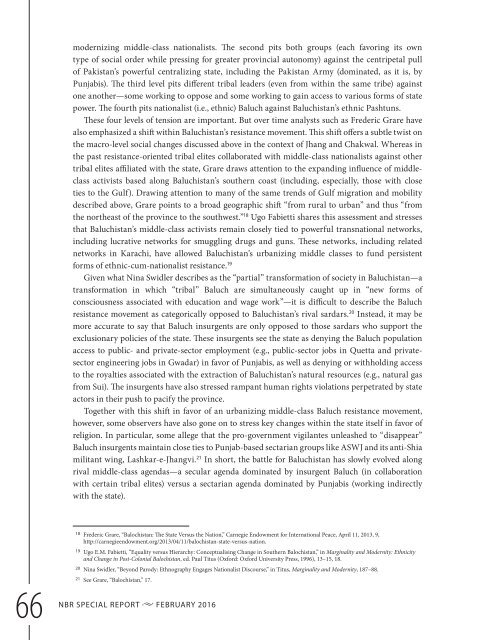pakistan’s
SR55_Mapping_Pakistan_February2016
SR55_Mapping_Pakistan_February2016
Create successful ePaper yourself
Turn your PDF publications into a flip-book with our unique Google optimized e-Paper software.
modernizing middle-class nationalists. The second pits both groups (each favoring its own<br />
type of social order while pressing for greater provincial autonomy) against the centripetal pull<br />
of Pakistan’s powerful centralizing state, including the Pakistan Army (dominated, as it is, by<br />
Punjabis). The third level pits different tribal leaders (even from within the same tribe) against<br />
one another—some working to oppose and some working to gain access to various forms of state<br />
power. The fourth pits nationalist (i.e., ethnic) Baluch against Baluchistan’s ethnic Pashtuns.<br />
These four levels of tension are important. But over time analysts such as Frederic Grare have<br />
also emphasized a shit within Baluchistan’s resistance movement. This shit offers a subtle twist on<br />
the macro-level social changes discussed above in the context of Jhang and Chakwal. Whereas in<br />
the past resistance-oriented tribal elites collaborated with middle-class nationalists against other<br />
tribal elites affiliated with the state, Grare draws attention to the expanding influence of middleclass<br />
activists based along Baluchistan’s southern coast (including, especially, those with close<br />
ties to the Gulf). Drawing attention to many of the same trends of Gulf migration and mobility<br />
described above, Grare points to a broad geographic shit “from rural to urban” and thus “from<br />
the northeast of the province to the southwest.” 18 Ugo Fabietti shares this assessment and stresses<br />
that Baluchistan’s middle-class activists remain closely tied to powerful transnational networks,<br />
including lucrative networks for smuggling drugs and guns. These networks, including related<br />
networks in Karachi, have allowed Baluchistan’s urbanizing middle classes to fund persistent<br />
forms of ethnic-cum-nationalist resistance. 19<br />
Given what Nina Swidler describes as the “partial” transformation of society in Baluchistan—a<br />
transformation in which “tribal” Baluch are simultaneously caught up in “new forms of<br />
consciousness associated with education and wage work”—it is difficult to describe the Baluch<br />
resistance movement as categorically opposed to Baluchistan’s rival sardars. 20 Instead, it may be<br />
more accurate to say that Baluch insurgents are only opposed to those sardars who support the<br />
exclusionary policies of the state. These insurgents see the state as denying the Baluch population<br />
access to public- and private-sector employment (e.g., public-sector jobs in Quetta and privatesector<br />
engineering jobs in Gwadar) in favor of Punjabis, as well as denying or withholding access<br />
to the royalties associated with the extraction of Baluchistan’s natural resources (e.g., natural gas<br />
from Sui). The insurgents have also stressed rampant human rights violations perpetrated by state<br />
actors in their push to pacify the province.<br />
Together with this shit in favor of an urbanizing middle-class Baluch resistance movement,<br />
however, some observers have also gone on to stress key changes within the state itself in favor of<br />
religion. In particular, some allege that the pro-government vigilantes unleashed to “disappear”<br />
Baluch insurgents maintain close ties to Punjab-based sectarian groups like ASWJ and its anti-Shia<br />
militant wing, Lashkar-e-Jhangvi. 21 In short, the battle for Baluchistan has slowly evolved along<br />
rival middle-class agendas—a secular agenda dominated by insurgent Baluch (in collaboration<br />
with certain tribal elites) versus a sectarian agenda dominated by Punjabis (working indirectly<br />
with the state).<br />
18 Frederic Grare, “Balochistan: The State Versus the Nation,” Carnegie Endowment for International Peace, April 11, 2013, 9,<br />
http://carnegieendowment.org/2013/04/11/balochistan-state-versus-nation.<br />
19 Ugo E.M. Fabietti, “Equality versus Hierarchy: Conceptualising Change in Southern Balochistan,” in Marginality and Modernity: Ethnicity<br />
and Change in Post-Colonial Balochistan, ed. Paul Titus (Oxford: Oxford University Press, 1996), 13–15, 18.<br />
20 Nina Swidler, “Beyond Parody: Ethnography Engages Nationalist Discourse,” in Titus, Marginality and Modernity, 187–88.<br />
66<br />
NBR<br />
21 See Grare, “Balochistan,” 17.<br />
SPECIAL REPORT u FEBRUARY 2016



